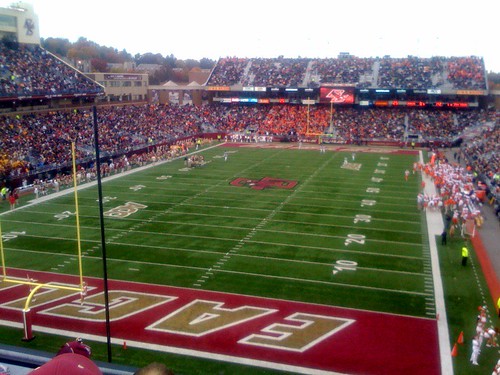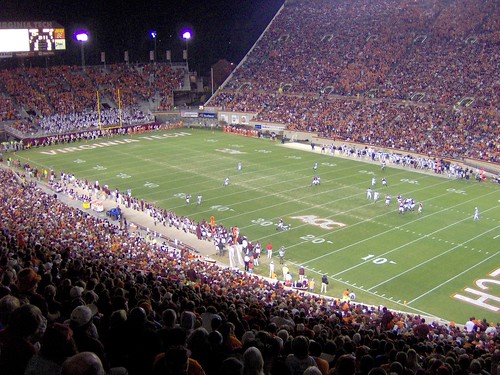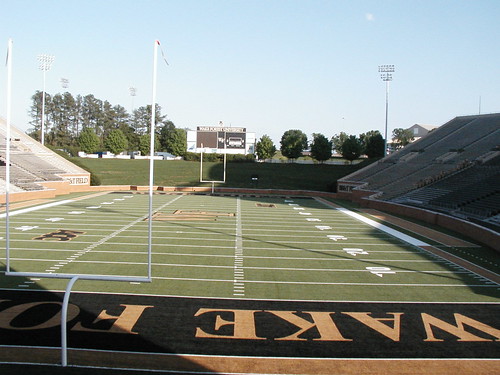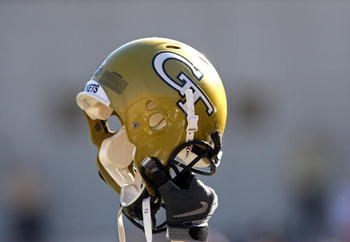Boston College: Alumni Stadium

Rebuilt in 1995, the original Alumni Stadium was constructed in 1915. New turf and architecture compliment the stadium well, and it overlooks the beautiful, forested Chestnut Hill area. While it is pretty, it is generally considered a small stadium for the size of the program.
Standing since: 1995
Capacity: 44,500
Surface: FieldTurf (installed in 2004)
Location: On campus (Chestnut Hill, MA)
Traditions: For Boston fight song
Clemson: Memorial Stadium (Death Valley)
The Tigers have ranked in the top 20 in attendance for 22 consecutive seasons, and the stadium has earned the nickname "Death Valley" for a reason. Memorial Stadium was built in a valley on the western part of campus, and the sea of loud, orange-clad fans pack the heated stands every home game, making it a very hostile environment for visiting teams.
Standing since: 1942
Capacity: 81,500
Surface: Grass
Location: On campus (Clemson, SC)
Traditions: Touching 'Howard's Rock' (above) before running down the hill onto the field before games. General orangeness.
Duke: Wallace Wade Stadium

If you thought Boston College's stadium was small, you clearly have yet to see Duke's. With a capacity of nearly 34 thousand, Wallace Wade Stadium is generally not considered a rough road environment for visiting ACC foes. The home team generally does not help the cause, as the Blue Devils have won just 13 games in the past five seasons.
Standing since: 1929
Capacity: 33,941
Surface: Grass
Location: On campus (Durham, NC)
Traditions: None..but there is an interesting fact; Wallace Wade Stadium (then called "Duke Stadium") was the only stadium to ever host the Rose Bowl outside of Pasadena, CA. Duke hosted the Rose Bowl in 1942, during World War II, when large gatherings on the West Coast were dangerous. In the game, Oregon State beat Duke, 20-16.
Florida State: Bobby Bowden Field (at Doak Campbell Stadium)

Formerly just "Doak Campbell Stadium", the Seminoles' home field was dedicated to former coaching great Bobby Bowden in 2004. In Florida State's last 130 home games, the 'Noles are 113-16-1. Tradition of good football, a strong fan base, and that sharp, Florida grass are what make this stadium one of the greatest in the nation.
Standing since: 1950
Capacity: 82,300
Surface: Bermuda grass (Florida grass)
Location: On campus (Tallahassee, FL)
Traditions: Seminole chop, Chief Osceola's (mascot) pregame throwing of the flaming spear at midfield while riding out on his horse, Renegade.
Georgia Tech: Bobby Dodd Stadium

Grant Field (in Bobby Dodd Stadium) is currently the oldest continuously-used house of on-campus college football in the FBS. Football has been played on Grant Field since 1905, and grandstands were added to the field in 1913. Bobby Dodd Stadium, named after the Yellow Jackets' all-time winningest coach, overlooks the beautiful cityscape of Atlanta.
Standing since: 1913 (field has existed since 1905)
Capacity: 55,000
Surface: Grass
Location: On campus (Atlanta, GA)
Traditions: Mascot 'Buzz' rides out onto the field in the 'Ramblin' Wreck',
a 1930 Ford Model A Sport Coupe, before the game.
Maryland: Byrd Stadium

Home of the Terps, Byrd Stadium held host to Queen Elizabeth and Prince Phillip's first American football game in 1957, not too long after the stadium's construction. On a clear day, the top of the Washington Monument can be seen from Byrd Stadium.
Standing since: 1950
Capacity: 54,000
Surface: Grass
Location: On campus (College Park, MD)
Traditions: Players touch the bronze terrapin located at the entrance to the stadium before charging out onto the field on gameday.
Miami (FL): Sun Life Stadium

Formerly playing in the Orange Bowl, the Hurricanes moved their home games to Sun Life Stadium (then Land Shark Stadium) in 2008. Sun Life Stadium plays host to the Hurricanes, Miami Dolphins of the NFL, and the Florida Marlins of the MLB, making it a very busy fall for the grounds crew. The 'Canes play some home games on infield dirt in September, as the Marlins' baseball season does not end until October.
Standing since: 1987 (then Joe Robbie Stadium)
Capacity: 75,192
Surface: Grass
Location: Off campus (Miami Gardens, FL- 21 miles north of campus)
Traditions: 'Touchdown Tommy' cannon fired off when team runs out of tunnel, also after 'Canes score. The Hurricanes run out of the tunnel through a thick fog of white smoke while a recording of hurricane noises blast out of the sound system; this tradition started during the program's rise to prominence in the '80's.
North Carolina: Kenan Memorial Stadium

As an unwritten rule, the Kenan Memorial Stadium can never be built higher than the pine trees surrounding the venue. Considered to be one of the most beautiful stadiums in the country, Kenan Memorial is engulfed by pines and a sea of Tar Heel blue that congregate every game day in Chapel Hill.
Standing since: 1927 (renovated in 2008)
Capacity: 62,980
Surface: Grass
Location: On campus (Chapel Hill, NC)
Traditions: The student section is nicknamed the "Tar Pit", and the light blue endzones are a rarity amongst college football.
North Carolina State: Carter-Finley Stadium

An average football program accompanied by an average football stadium, Carter-Finley Stadium is not the most interesting stadium in the ACC. While it might be bland, the sidelines are interesting. This venue has the smallest space between the sidelines and the stands of any stadium in the ACC, and while the playing field is natural grass, the sidelines are artificial turf.
Standing since: 1966
Capacity: 57,583
Surface: Grass
Location: On campus (Raleigh, NC)
Traditions: Red and White fight song
Virginia: Scott Stadium

Scott Stadium provides a nice view of Monticello Mountain at the south end of the stadium, as well as a view of the Blue Ridge Mountains. Hill seating, a common feature of ACC stadiums, is surrounded by traditional white columns at Scott Stadium, which provide a colonial look to one of the oldest universities in the country (founded by Thomas Jefferson in 1819).
Standing since: 1931
Capacity: 61,500
Surface: Grass
Location: On campus (Charlottesville, VA)
Traditions: Cavalier mascot leads team onto field on horseback, pointing his sword forward in allegiance. Orange and blue fireworks go off as the Cavaliers run onto the field.
Virginia Tech: Lane Stadium

In 2005, Rivals.com ranked Lane Stadium as the #1 home-field advantage venue in all of college football. ESPN.com ranked Lane Stadium #2 on their list of the "Top 10 Scariest Places To Play". The stadium also has the highest elevation of any college football stadium east of the Mississippi river. Least to say, Lane Stadium is the ultimate home field. And to prove it, the Hokies have the most wins of any team in ACC history, with 679 wins.
Standing since: 1965 (renovated in 2006)
Capacity: 66,233
Surface: Grass
Location: On campus (Blacksburg, VA)
Traditions: Virginia Tech's Corps of Cadets fire "Skipper", the world's largest game cannon, after every touchdown and after the National Anthem. The freshman Cadets also do pushups after every score, equaling the point total for the Hokies. As the Hokies enter the stadium, all players slap a piece of "Hokie Stone" as Enter Sandman blares from the speakers.
Wake Forest: BB&T Field (at Groves Stadium)

Groves Stadium is the smallest stadium (capacity-wise) in all of the BCS. Like many ACC stadiums, it contains a grass hill at one endzone, and the hill behind the southeast endzone is called "Deacon Hill". Unlike many ACC stadiums, BB&T field is made of "FieldTurf" (since 2006), the newest, most natural-looking turf in stadiums today.
Standing since: 1968
Capacity: 31,500
Surface: FieldTurf
Location: On campus (Winston-Salem, NC)
Traditions: Demon Deacon (mascot) rides a motorcycle onto the field before every game.
THE AWARDS:
Ranking the ACC's stadiums in many different categories.
 Biggest stadium:
Biggest stadium:1. Florida State
2. Clemson
3. Miami (FL)
4. Virginia Tech
5. North Carolina
6. Virginia
7. NC State
8. Georgia Tech
9. Maryland
10. Boston College
11. Duke
12. Wake Forest
 Oldest stadium:
Oldest stadium:1. Georgia Tech
2. North Carolina
3. Duke
4. Virginia
5. Clemson
6. Florida State
6. Maryland
7. Virginia Tech
8. NC State
9. Wake Forest
10. Miami (FL)
11. Boston College
Best tradition:
 1. Florida State (Chief Osceola)
1. Florida State (Chief Osceola)2. Miami (FL) (Smoke entrance)
3. Clemson (Howard's Rock)
4. Virginia Tech (Hokie Stone, Enter Sandman entrance)
5. Virginia (Horseback Cavalier)
6. Georgia Tech (Buzz on a motorcycle)
7. Wake Forest (Demon Deacon on a motorcycle)
8. Maryland (bronze terrapin)
9. North Carolina ('Tar Pit')
10. NC State (fight song)
11. Boston College (fight song)
12. Duke (N/A)
 Prettiest stadium:
Prettiest stadium:1. North Carolina
2. Virginia
3. Georgia Tech
4. Duke
5. Wake Forest
6. Boston College
7. NC State
8. Maryland
9. Clemson
10. Florida State
11. Virginia Tech
12. Miami (FL)
Best endzone design:
1. Virginia
2. North Carolina
3. Maryland
4. Clemson
5. NC State
6. Wake Forest
7. Florida State
8. Miami (FL)
9. Virginia Tech
10. Duke
11. Boston College
12. Georgia Tech
Best stadium (overall):
1. Clemson
 2. Virginia
2. Virginia3. Florida State
4. Virginia Tech
5. North Carolina
6. Georgia Tech
7. Maryland
8. Boston College
9. NC State
10. Wake Forest
11. Duke
12. Miami (FL)
On a side note...
Only 2/12 fields were turf (Boston College and Wake Forest).
Only 1 stadium was off-campus (Miami (FL)).
The oldest stadium was opened in 1913 (Georgia Tech), while the newest stadium was opened in 1995 (Boston College).
Next week, I tour the BIG 12!
